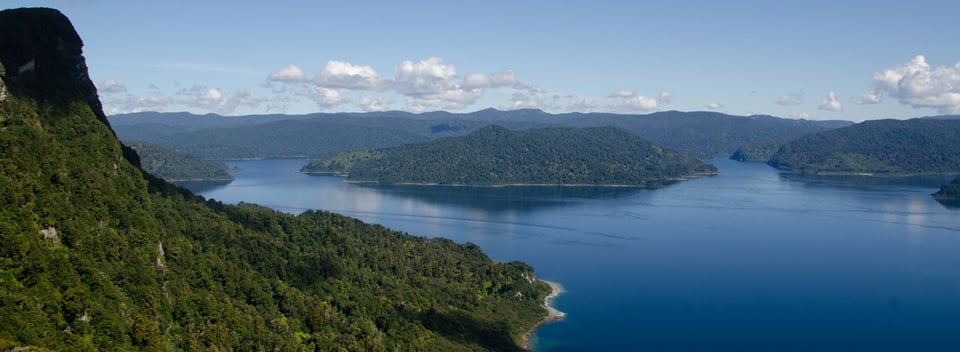
Lake Waikaremoana Track
When the smell of the earth fills your lungs, when droplets of water gently fall from native leaves, when treetops chatter with birdsong, and mist crawls through the valleys, it’s easy to feel like the forest around you is a living being.
Te Urewera, the 2127 sq km (821 sq mil) area in which the Lake Waikaremoana Track lies, is so sacred in the hearts of New Zealand Māori iwi (tribe), Ngāi Tūhoe, it’s become the first natural resource in the world to be given the same legal rights as a living person.
This legal precedent is the Crown’s way of giving redress to the Tūhoe people, after historically confiscating their land, and restoring guardianship to them, so they can ensure Te Urewera remains a taonga (a treasure) to be enjoyed by manuhiri (visitors - like yourself!) and future generations of the iwi.

The tranquil water of Lake Waikaremoana
Where can I find this taonga?
Lake Waikaremoana Track is one of the most isolated Great Walks in New Zealand, making it perfect for hikers wanting to experience some exquisite kiwi tramping, off the beaten track.
The walk, which totals 46km (29 miles) can be accessed from either of its two sides at Onepoto or Hopuruahine Landing.
To access either end, you’ll want to start from Te Karetu, about 2.5 hours west of Gisborne, where the Te Urewera Visitor Centre is.
To start from Onepoto, from the visitor centre, follow State Highway 38 south for about 20 minutes.
Alternatively, you can take Lake Rd/Te Urewera Rainforest Rte/Waikaremoana Rd for about 30 minutes northwest of the visitor centre however as the road becomes gravel, it’s not suitable for 2WD vehicles, so 4WD is a must!
When you’ve finished your walk, you have the option for walking back the way you came to your parked vehicle, sorting a key swap with some other walkers, or during Great Walks season (October to April) the iwi, Ngāi Tūhoe, operate a water taxi on the lake, how fun!
The Great Walk
Most manuhiri will start the walk from the Onepoto side and tackle the most elevation on the first day.
Generally, people will spread the walk into three or four days and so you know what to expect when you embark on this epic trail, we’ve broken each day down for you.
Day one: Onepoto to Panekire hut, 4 - 6 hours, 9km (5.6 miles)
Beginning from the Onepoto shelter, before embarking on your climb for the day, you’ll pass through a piece of complex New Zealand history - the former Armed Constabulary Redoubt, constructed in 1871 as part of a campaign against guerilla fighter Te Kooti, one of the most significant Māori leaders of the 19th century.
It was here, Armed Constabulary troops invaded and guarded the ‘frontier’ to Te Urewera, against Te Kooti, while a government boat also patrolled Lake Waikaremoana.
Leaving this historical site, you’ll gradually climb the Panekire bluff, traverse an undulating ridgeline until you reach Puketapu Trig having gained an impressive 1180m (3871ft) elevation.
Along the way you’ll walk on a carpet of red beech leaves and enchanting moss and fern species before the forest evolves into silver beech trees at higher altitudes.
With your heart thumping atop the Panekire range, take in brilliant views of Lake Waikaremoana and surrounding mountains on a clear day, and walk among the mystical fog on a cloudy one.
Panekire hut is just a short distance further.
Huts and campsites need to be booked all year round so make sure you get that sussed before you leave, otherwise you may not have a place to rest your legs after a hearty days’ walking!
Panekire hut has 36 bunks, heating, non-flushing toilets, and running tap water - which needs to be boiled before use.

Lake Waikaremoana feeds the Waikaretaheke River.
Day two: Panekire hut to Marauiti hut, 8.5 hours, 19.7km (12 miles)
Today will be one for the Fitbit as we get in a good chunk of walking with some great little spots to stop along the way.
Thankfully, it’s nothing like yesterday’s climb – the first part of your hike takes you down the range and under the cover of beech, podocarp and kamahi forest onto a reasonably flat section.
You’ll get to see the lake from a different angle as you come down to the shoreline and walk through beautiful Toi Toi to the crystal clear waters of Waikaremoana. This is the perfect spot to cool off about halfway along the longest leg of your hike.
You’ll continue on through open fields with more Toi Toi, (some with lupins depending on the time of year), swing bridges, fern canopies and misty valleys.
About five hours into your tramp you’ll come to Korokoro campsite and from here you can take an hour’s detour to Korokoro falls which comes highly recommended by almost every tramper that takes the opportunity.
It’s a curtain waterfall at 22m (72ft) high and like most good-sized waterfalls, you’ll hear it before you see it!
Finally, after a brief climb over Whakaneke Ridge, you’ll come to Marauiti hut which sits alongside a small inlet of Lake Waikaremoana called Wairaomoana.
Much like Panekire hut, Marauiti hut has heating, non-flushing toilets, tap water (that must be boiled before use) and is slightly smaller at 26 bunks.

Water tumbles down the sheer vertical stone walls.
Day three: Marauiti hut to Waiharuru hut, 2 hours, 6.2km (3.9 miles)
A short walk, but a necessary overnight stay if you want to hear the call of our most-loved bird and namesake, the kiwi!
Your two-hour tramp is flat with slight undulations where you’ll cross a bridge then a saddle to get back to the shoreline at Te Totara Bay. You then follow the shoreline to Waiharuru hut… why not stop for a swim along the way? With only two hours walking, you’ve got heaps of time!
Nighttime is the perfect time for a walk and to listen for the call of the kiwi. If you do spot one, lucky you! That’s pretty rare. Just remember, our national bird is endangered and we don’t want to stress them out. Here’s some top tips for keeping kiwi safe:
-
Keep a distance of at least a metre (3ft)
-
Don’t shine torches at them or use flash photography
-
Don’t follow a kiwi into the bush (their nest might be close by!)
-
Be calm and avoid any sudden movements
After your nighttime adventure, you’ll rest up at Waiharuru hut which has 40 bunk beds, heating, non-flushing toilets and tap water that must be boiled before use.
Day four: Waiharuru hut to water taxi or Hopuruahine Landing, 4.5 hours, 7.3km (4.5 miles)
Your final leg of the track is short and sweet.
The walk begins flat before gently rising over the neck of the Puketukuku Peninsula then down to the Tapuaenui campsite, which is about 1.5 hours in.
After a further hour, you’ll reach Whanganui hut which is just 300m (984ft) away from the water taxi pick up/drop off. This is where you’ll bid the track goodbye and start your hasty return across the lake, back to the start of the track.
If you’re finishing your walk at Hopuruahine Landing, from Whanganui Hut you’ll climb a little above the lake shore and over the ridgeline into Huiarau Stream before crossing the Hopuruahine river flats and Hopuruahine suspension bridge. Viola! You’re done.
Of course, you can change up the walk any way you like – we’ve given you a guide for a four-day tramp, staying in huts, with a decent chunk of walking between Panekire hut and Marauiti hut, and a special stay at Waiharuru hut where you might hear some kiwi.
However, it’s really up to you how you space out your walk. Check out the full list of huts and campsites to choose from below!
-
Panekire Hut (8.8km/5.5mi from Onepoto)
-
Waiopaoa Hut and Campsite (7.6km/4.7mi from Panekire Hut)
-
Korokoro Campsite (3.6km/2.2mi from Waiopaoa Hut)
-
Maranui Campsite (6.8km/4.2mi from Korokoro Campsite)
-
Marauiti Hut (1.7km/1mi from Maranui Campsite)
-
Waiharuru Hut and Campsite (6.2km/3.9mi from Marauiti Hut)
-
Tapuaenui Campsite (2.1km/1.3mi from Waiharuru Hut)
*Please note, Whanganui Hut is closed.
Significance to Māori
Te Urewera is a sacred place to Māori.
It is home to Hine-Pukohu-Rangi, the Mist Maiden, who you will often see wandering the valleys during your walk. The local iwi (tribe) Ngāi Tūhoe, see Hine-pukohu-rangi as their ancestor and are known as ‘children of the mist’. They’re committed to their duty of protecting the land – which is the first natural resource to be granted the same legal rights as a person.
Unlike the other Great Walks and Great Walk huts, which are maintained by government organisation, the Department of Conservation, Lake Waikaremoana Track and its huts are cared for by Te Uru Taumatua board who are the Kaitiaki (guardians) of the land.
The board is made up by three Crown representatives and six Ngāi Tūhoe representatives to establish and preserve in perpetuity the legal identity of Te Urewera in accordance with the Te Urewera Act 2014 which states:
-
Te Urewera is ancient and enduring, a fortress of nature, alive with history; its scenery is abundant with mystery, adventure, and remote beauty.
-
Te Urewera is a place of spiritual value, with its own mana (prestige/authority) and mauri (life force).
-
Te Urewera has an identity in and of itself, inspiring people to commit to its care.
The Act was brought forward as part of a Treaty of Waitangi settlement to address the hurt caused by the confiscation of Te Urewera from Ngāi Tūhoe in the mid-1860s when Ngāi Tūhoe were wrongly accused of being in ‘rebellion’ during the New Zealand Land Wars.
Government troops then invaded Te Urewera in search of Te Kooti Arikirangi – a rebel and prophet.
In 2013 the Ngāi Tūhoe people were awarded a settlement of a total financial value of about NZD$170 million and Te Urewera was granted the same legal rights as a living person. Moving forward Ngāi Tūhoe works alongside the government to care for Te Urewera in perpetuity and lead restoration programmes for endangered native birds, tourism initiatives and more.
Many Tūhoe still reside in the area today, and some are still continuing traditional food-gathering practices carried out by their ancestors for hundreds of years.
It’s important to be a good manuhiri (visitor) to this region, and many others in New Zealand, to respect tribal legacies and ensure they are protected for years to come.
Keen to check out some of Aotearoa’s other Great Walks but limited on time? Check out our Great Walk Adventure - our awesome team will take care of the finer details, all you need to do is hike!
Want to learn more about our New Zealand Trails trips? Get a copy of our FREE BROCHURE HERE!








Comments
Let’s talk – we’d love to hear what you think. Pop your details in below and have your say.
No one has commented on this page yet.
RSS feed for comments on this page | RSS feed for all comments